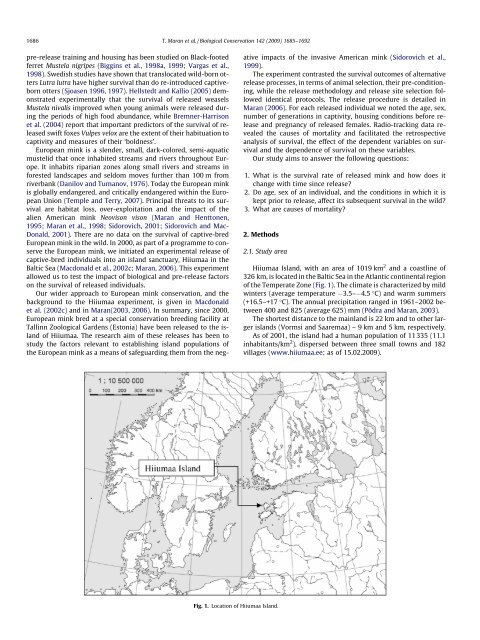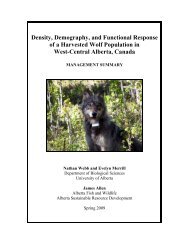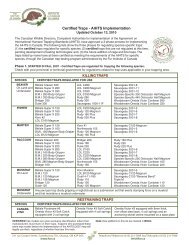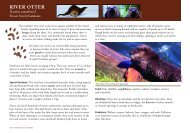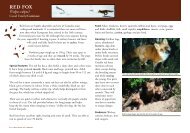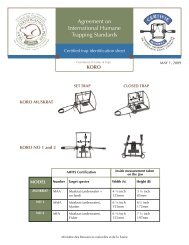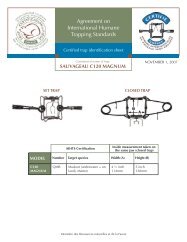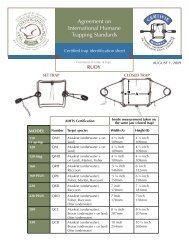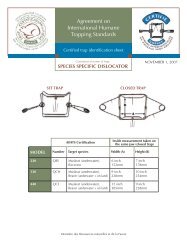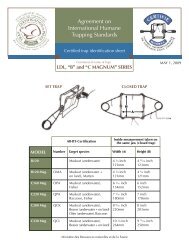1686 T. Maran et al. / Biological Conservation 142 (2009) 1685–1692pre-release training and housing has been studied on Black-footedferret Mustela nigripes (Biggins et al., 1998a, 1999; Vargas et al.,1998). Swedish studies have shown that translocated wild-born ottersLutra lutra have higher survival than do re-introduced captivebornotters (Sjoasen 1996, 1997). Hellstedt and Kallio (2005) demonstratedexperimentally that the survival <strong>of</strong> released weaselsMustela nivalis improved when young animals were released duringthe periods <strong>of</strong> high food abundance, while Bremner-Harrisonet al. (2004) report that important predictors <strong>of</strong> the survival <strong>of</strong> releasedswift foxes Vulpes velox are the extent <strong>of</strong> their habituation tocaptivity and measures <strong>of</strong> their ‘boldness’.European mink is a slender, small, dark-colored, semi-aquaticmustelid that once inhabited streams and rivers throughout Europe.It inhabits riparian zones along small rivers and streams inforested landscapes and seldom moves further than 100 m fromriverbank (Danilov and Tumanov, 1976). Today the European minkis globally endangered, and critically endangered within the EuropeanUnion (Temple and Terry, 2007). Principal threats to its survivalare habitat loss, over-exploitation and the impact <strong>of</strong> thealien American mink Neovison vison (Maran and Henttonen,1995; Maran et al., 1998; Sidorovich, 2001; Sidorovich and Mac-Donald, 2001). There are no data on the survival <strong>of</strong> captive-bredEuropean mink in the wild. In 2000, as part <strong>of</strong> a programme to conservethe European mink, we initiated an experimental release <strong>of</strong>captive-bred individuals into an island sanctuary, Hiiumaa in theBaltic Sea (Macdonald et al., 2002c; Maran, 2006). This experimentallowed us to test the impact <strong>of</strong> biological and pre-release factorson the survival <strong>of</strong> released individuals.Our wider approach to European mink conservation, and thebackground to the Hiiumaa experiment, is given in Macdonaldet al. (2002c) and in Maran(2003, 2006). In summary, since 2000,European mink bred at a special conservation breeding facility atTallinn Zoological Gardens (Estonia) have been released to the island<strong>of</strong> Hiiumaa. The research aim <strong>of</strong> these releases has been tostudy the factors relevant to establishing island populations <strong>of</strong>the European mink as a means <strong>of</strong> safeguarding them from the negativeimpacts <strong>of</strong> the invasive American mink (Sidorovich et al.,1999).The experiment contrasted the survival outcomes <strong>of</strong> alternativerelease processes, in terms <strong>of</strong> animal selection, their pre-conditioning,while the release methodology and release site selection followedidentical protocols. The release procedure is detailed inMaran (2006). For each released individual we noted the age, sex,number <strong>of</strong> generations in captivity, housing conditions before releaseand pregnancy <strong>of</strong> released females. Radio-tracking data revealedthe causes <strong>of</strong> mortality and facilitated the retrospectiveanalysis <strong>of</strong> survival, the effect <strong>of</strong> the dependent variables on survivaland the dependence <strong>of</strong> survival on these variables.Our study aims to answer the following questions:1. What is the survival rate <strong>of</strong> released mink and how does itchange with time since release?2. Do age, sex <strong>of</strong> an individual, and the conditions in which it iskept prior to release, affect its subsequent survival in the wild?3. What are causes <strong>of</strong> mortality?2. Methods2.1. <strong>Study</strong> areaHiiumaa Island, with an area <strong>of</strong> 1019 km 2 and a coastline <strong>of</strong>326 km, is located in the Baltic Sea in the Atlantic continental region<strong>of</strong> the Temperate Zone (Fig. 1). The climate is characterized by mildwinters (average temperature 3.5– 4.5 °C) and warm summers(+16.5–+17 °C). The annual precipitation ranged in 1961–2002 between400 and 825 (average 625) mm (Põdra and Maran, 2003).The shortest distance to the mainland is 22 km and to other largerislands (Vormsi and Saaremaa) – 9 km and 5 km, respectively.As <strong>of</strong> 2001, the island had a human population <strong>of</strong> 11335 (11.1inhabitants/km 2 ), dispersed between three small towns and 182villages (www.hiiumaa.ee; as <strong>of</strong> 15.02.2009).Fig. 1. Location <strong>of</strong> Hiiumaa Island.
T. Maran et al. / Biological Conservation 142 (2009) 1685–1692 1687Forest covers around 70% <strong>of</strong> the island, and more than 22 naturereserves encompass over 20% <strong>of</strong> the land area (www.eelis.ee; as<strong>of</strong>15.02.2009).2.1.1. FaunaIn addition to the European mink, the mammal fauna <strong>of</strong> the islandincludes eight carnivore species – weasel M. nivalis, stoat Mustelaerminea, pine marten Martes martes, otter L. lutra, raccoon dogNyctereutes procyonoides, red fox Vulpes vulpes, lynx Felis lynx andwolf Canis lupus. There are records <strong>of</strong> earlier occurrence <strong>of</strong> polecatMustela putorius and American mink Neovison vison in the islandbut the American mink was eradicated in 1998–2000 (Macdonaldet al., 2002c). Other semi-aquatic mammals include beaver Castorfiber, northern water vole Arvicola terrestris and water shrew Neomysfodiens. At least eight species <strong>of</strong> small rodents have been recordedin Hiiumaa (Põdra and Maran, 2003).The possible competitors and predators <strong>of</strong> the European minkamong the local raptors are white-tailed eagle Haliaetus albicilla,golden eagle Aquila chrysaetos, eagle owl Bubo bubo, Ural owl Strixuralensis, common buzzard Buteo buteo, northern goshawk Accipitergentilis, northern harrier Circus cyaneus, Montagu’s harrier Circuspygargus and marsh harrier Circus aeruginosus (Põdra and Maran,2003).Amphibians are represented by five species. Common frog Ranatemporaria, moor frog Rana arvalis and common toad Bufo bufo arecommon. Natterjack toad Bufo calamita and common newt Triturusvulgaris are rare. Reptiles are represented by common viper Viperaberus, grass snake Natrix natrix, slow worm Anguis fragilis and commonlizard Lacerta vivipara (Põdra and Maran, 2003).The following fish species have been recorded in the inlandwater bodies <strong>of</strong> Hiiumaa: Esox lucius, Perca fluviatilis, Gymnocephaluscernus, Salmo trutta, Lota lota, Anguilla anguilla, Gasterosteusaculeatus, Pungitius pungitius, Rutilus rutilus, Leuciscus leuciscus, Leuciscusidus, Leucaspius delineatus, Carassius carassius, Tinca tinca,Lamperta fluviatilis. Populations <strong>of</strong> crayfish Astacus astacus exist infour water courses (Põdra and Maran, 2003).2.1.2. Inland water bodiesThere are 40 bigger streams or rivers (with the total length <strong>of</strong>326 km) in the island and 100 km <strong>of</strong> bigger drainage ditchesand 13 lakes with the total length <strong>of</strong> shoreline <strong>of</strong> 25 km (Põdraand Maran, 2003).2.2. Origin <strong>of</strong> released animalsThe released animals were born in captivity at the conservationbreeding facility <strong>of</strong> Tallinn Zoological Gardens, which is coordinatedby the European mink EEP programme (European EndangeredSpecies Program under the European Association <strong>of</strong> Zoosand Aquaria, www.eaza.net). The captive management followsthe European mink EEP captive breeding and husbandry guidelines(unpublished document: accepted by, and lodged with, Europeanmink EEP animal committee in 2005). The founders <strong>of</strong> the EEP captivepopulation originate from Tver, Vologda, Pskov, Novgorod andLeningrad Regions <strong>of</strong> Russia. These regions are considered to beinhabited by one subspecies – M. lutreola novikovi (Heptner et al.,1967) though the validity <strong>of</strong> subspecies for M. lutreola has beenquestioned (Michaux et al., 2005; Youngman, 1982).2.3. Methodology <strong>of</strong> releaseBefore release, the animals were provided an opportunity tocatch the prey they were likely to encounter on the island, andtheir contact with humans (keepers) was reduced to a minimum(human presence was restricted to unavoidable husbandry). Further,the animals were checked for their ability to swim and, asnecessary, ‘coached’ through encouraging the use <strong>of</strong> artificialponds (see Macdonald et al., 2002c for details). Releases followeda hard release protocol – transportation from the breeding facilityto the release area, where individuals were set free in the mostsuitable habitats – that is riverbanks <strong>of</strong> small rivers or canalswith lush riparian vegetation and abundant prey. Transport wasover a distance <strong>of</strong> c. 150 km and lasted some four to five hours,including a 1.5-h ferry trip. The majority <strong>of</strong> the radio-tracked releasedindividuals travelled widely, the survivors settling inestablished home ranges after 1–2 months (Macdonald et al.,2002c).2.4. Radio-trackingFifty-four out <strong>of</strong> the 172 released mink were equipped withradio-collars (Biotrack, UK; Table 1). In open terrain the signalswere detectable at 1 km, and in woodland at 600 m. The lifespan<strong>of</strong> transmitters was around six month and their weight(14 g) constituted 2% <strong>of</strong> male and 3% <strong>of</strong> female weight. The samplesize was reduced due to some transmitter failures and, as iscommonplace in radio-tracking studies <strong>of</strong> mustelines, becausethe thick neck and narrow head <strong>of</strong> the mink resulted in occasionalloss <strong>of</strong> radio-collars (Table 2).The receivers used were TR-4 (Telonics; USA) and R-1000 (CommunicationSpecialist; USA).After the release, the animals’ locations were recorded 1–3times a day during the first week, every day during the next 20days, every two days during the second and third month, and oncea week thereafter. The status <strong>of</strong> the free-living mink was regularlymonitored by spring and autumn live-trapping (Table 2).2.5. <strong>Survival</strong> analysesLive-trapping records revealed that a proportion <strong>of</strong> the releasedanimals survived for up to 39 months. However, for the sake <strong>of</strong>consistency, we included only radio-tracked individuals in theseanalyses, but excluded eight juveniles released exceptionally in autumn(Table 2).Failure time analyses were used to study the survival <strong>of</strong> animalsafter release and the effect <strong>of</strong> co-variables on their survival. Theanimals were divided into groups by variable values (age class,sex, enclosure <strong>of</strong> origin, number <strong>of</strong> generations in captivity, yearTable 1Number <strong>of</strong> released European mink in 2000–2003.Year Number <strong>of</strong> releases With radio-collarsMales Females Total released In summer In autumnNon-pregnantPregnant2000 8 9 0 17 9 8 172001 19 22 0 41 41 0 232002 23 19 12 54 39 15 122003 32 14 14 60 42 18 2Total 82 64 26 172 131 41 54


